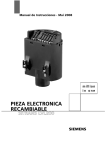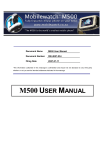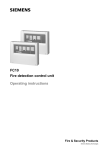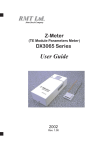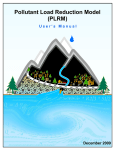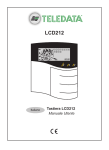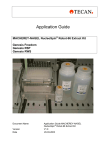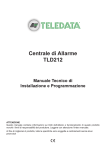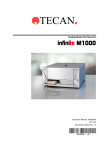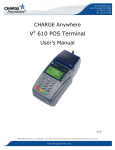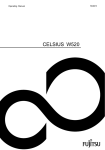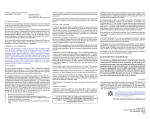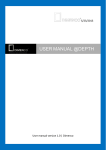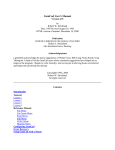Download Cerberus CerGas Software tool SWE60 User manual
Transcript
Cerberus® CerGas Software tool SWE60 User manual Fire & Security Products Siemens Building Technologies Data and design subject to change without notice. / Supply subject to availability. © Copyright by Siemens Building Technologies AG We reserve all rights in this document and in the subject thereof. By acceptance of the document the recipient acknowledges these rights and undertakes not to publish the document nor the subject thereof in full or in part, nor to make them available to any third party without our prior express written authorization, nor to use it for any purpose other than for which it was delivered to him. 1. INTRODUCTION ..............................................................................................................................................1 1.1 PURPOSE ....................................................................................................................................................1 1.2 USER INTERFACE .........................................................................................................................................1 1.3 USER PROFILE .............................................................................................................................................1 1.4 SYSTEM REQUIREMENTS ..............................................................................................................................2 1.4.1 Ordering information ..........................................................................................................................2 1.5 STARTING SWE-60 .....................................................................................................................................2 1.6 OPERATION .................................................................................................................................................2 2. STARTING SWE60 MENU SHELL .................................................................................................................3 2.1 2.2 2.3 2.4 3. OPENING SCREEN ........................................................................................................................................3 MENU "GENERAL"........................................................................................................................................3 MENU "SYSTEM DISK" .................................................................................................................................4 SWE 60 SYSTEM EDITOR.............................................................................................................................4 SWE60 SYSTEM EDITOR FUNCTIONS.........................................................................................................5 3.1 GENERAL AND OPERATION ...........................................................................................................................5 3.2 SWE SYSTEM EDITOR MENU INTERFACE .......................................................................................................5 3.3 MENU "GENERAL"........................................................................................................................................6 3.3.1 Setup..................................................................................................................................................6 3.3.2 Printer.................................................................................................................................................7 3.4 MENU "CONTROL UNIT"................................................................................................................................8 3.4.1 Data transfer CC ---> SWE ................................................................................................................8 3.4.2 Data transfer SWE ---> CC ..............................................................................................................10 3.4.3 Software update ...............................................................................................................................10 3.5 MENU "FILE" .............................................................................................................................................11 3.5.1 New ..................................................................................................................................................11 3.5.2 Open ................................................................................................................................................12 3.5.3 Save .................................................................................................................................................13 3.5.4 Convert.............................................................................................................................................13 3.5.5 Create list .........................................................................................................................................14 3.5.6 Delete...............................................................................................................................................15 3.6 MENU "EDIT" .............................................................................................................................................16 3.6.1 Operation - General .........................................................................................................................16 3.6.2 System parameters..........................................................................................................................17 3.6.2.1 System times ...................................................................................................................................18 3.6.3 Hardware..........................................................................................................................................19 3.6.4 Interfaces .........................................................................................................................................20 3.6.5 Detection lines..................................................................................................................................21 3.6.6 Detector parameters ........................................................................................................................22 3.6.6.1 ASSIGNMENT DETECTOR / FE.....................................................................................................22 3.6.6.2 Bar display configuration..................................................................................................................23 3.6.6.3 Alarm hold ........................................................................................................................................24 3.6.6.4 General configuration.......................................................................................................................24 3.6.6.5 Inversion of alarms...........................................................................................................................25 3.6.6.6 Alarm release FA/WA/PA/AL ...........................................................................................................26 3.6.6.7 Sensor type ......................................................................................................................................26 3.6.6.8 Analogue outputs configuration .......................................................................................................27 3.6.6.9 Calibration gas concentration ..........................................................................................................28 3.6.6.10 Set threshold values (WA/PA/AL) ................................................................................................28 3.6.7 Copy function ...................................................................................................................................29 3.6.8 Control zones ...................................................................................................................................30 3.6.8.1 Detector assignment ........................................................................................................................31 3.6.8.2 Relay assignment ............................................................................................................................32 3.6.8.3 On / Off delay ...................................................................................................................................33 3.6.8.4 Alarm hold ........................................................................................................................................34 3.6.8.5 Zone activity/ Alarm outputs.............................................................................................................35 I Siemens Building Technologies Fire & Security Products 10.2002 Modifications Version Date Description e1369c 04.2000 SIEMENS layout new. Section 1.4: Ordering information modified e1369d 08.2002 Information about saving e1369e 10.2002 Design II Siemens Building Technologies e1369e Fire & Security Products 10.2002 1. 1.1 Introduction Purpose SWE-60 is an application which runs on the CW100-03 Cerberus Service tool (notebook/laptop). The tool supports configuration and parameterization, and also data backup for the CC-60 gas detection system control unit. The program is largely linked into the existing CS menu shell (SWE menu) and has been adapted to this specification. 1.2 User interface The user interface is adapted as far as possible to the CS standard (MODULA-2 mode interface). Thus the tool is defined to be usable with an SAA window-oriented user interface. Deviations from standard CS operation are described in this user manual. The user interface has been developed to allow extremely simple language adaptations. 1.3 User profile The user group is defined as consisting of the service engineers, project members and construction site supervisors. The user interface has thus been defined according to the CS standard. The project member and construction site supervisor will typically use the tool in the office to pre-program a gas detection system. The service engineer will typically use the tool on the customer's site for servicing and commissioning work on gas detection systems. 1 Siemens Building Technologies e1369e Fire & Security Products 10.2002 1.4 System requirements The tool requires the following platform as a minimum configuration: Computer Operating system RAM EM 368.exe Smart drive Mass storage Screen Keyboard Interfaces Copy protection Accessory 1.4.1 Ordering information Item SWE 60-01 M3C 060 B3D 021 AT CABLE - 1.5 : IBM AT (or compatible) : MS-DOS/PC-DOS v6.2x : at least 550 KB free memory ® disabled ® disabled : HD / FD : CGA / EGA / VGA : PC / XT / AT, mouse optional : 1 x RS232, 1 Centronics : protected by dongle on LPT1 : B3D021 modem with data cable Part no ® OSS 462088 505259 427667 417279 466453 433842 Designation Parameter editor for SWE 60 DONGLE D FULL V24 DUAL MODEM AT cable 9f/25m; L=0.25m Cable 25f/25m; L=2m Ribbon AT modem cable 25m/9f / L=4.5m MONITOR CABLE 9f / 9m./ L=3m Starting SWE-60 The program is always started from the CS menu shell (SWE). The program is started using the command "SWE60" (Cerberus specification batch file). The program will not run unless the dongle (M3 C060 / CC60 / 462 075 CS specified) is connected to the computer's printer port. 1.6 Operation The program is operated through the keyboard using hotkeys, function keys and the tab key. The program optionally supports a mouse on the serial ports COM1 or COM2. The dialogue language is the national language of the installation country, this can be selected in a configuration file. See the Cerberus guidelines and the operating element listed in the documents "PC Setup / Installation / Operation" (e996a) and "SWUDSK" (e969a) for further operations. (Documentation in "SWTS 60" file) 2 Siemens Building Technologies e1369e Fire & Security Products 10.2002 2. 2.1 Starting SWE60 menu shell Opening screen The opening screen appears once the SWE60 tool is started from the Cerberus menu shell. The dropdown menus can be opened using the <Ins> key. 2.2 Menu "General" An information box can be opened under the "General" menu. The User Manual is opened under "Manual". SWE60 is also closed by selecting "End" in this menu. 3 Siemens Building Technologies e1369e Fire & Security Products 10.2002 2.3 Menu "System Disk" A system disk must first be created using the SWUDSK program before the SWE60 system editor can be started. The functions of the SWUDSK program are described in document "SWUDSK" e969a. 2.4 SWE 60 system editor The opening screen is displayed when the SWE60 system editor is started. It includes all the instructions necessary for the functions of the SWE60 system editor. These include, e.g., the presence of the dongle (M3C060) in the parallel port, the installation diskette in drive "A", etc. 4 Siemens Building Technologies e1369e Fire & Security Products 10.2002 3. SWE60 system editor functions 3.1 General and Operation Press the <F10>function key or the key combination <Alt> and <hotkey> to open a dropdown menu. A menu item in a dropdown menu may be selected with the <up/down arrow key>, and opened with the <Spacebar> or the <Enter> key. The parameters within a menu item available for editing may be selected with the <tab key>. The edited data can be accepted by selecting the "OK" button and pressing the <Spacebar> or <Enter>. To discard the parameters, select the "CANCEL" button and press the <Spacebar> or <Enter>. 3.2 SWE system editor menu interface When the system editor is started, a menu bar with the options General, Control unit, File and Edit is displayed. The Edit option can only be activated after opening a new or existing system. The functions for the various options are described below. 5 Siemens Building Technologies e1369e Fire & Security Products 10.2002 3.3 Menu "General" This menu includes the functions "About“ for the SWE60 system editor, “Setup“ and "Quit" which you can use to leave the system editor. 3.3.1 Setup Use the "Setup" function to change the screen from monochrome to color display. Any printer port will be configured here. 6 Siemens Building Technologies e1369e Fire & Security Products 10.2002 3.3.2 Printer The parallel or serial port is configured under the function "Selection“. The port can be selected under the function "Port" The port desired can be selected using the <cursor keys> and confirmed with the <Tab key> by selecting "OK". Note: The printer driver CWPRINT.EXE, which is located in c:\swe60\sys will be used for printing. 7 Siemens Building Technologies e1369e Fire & Security Products 10.2002 3.4 Menu "Control unit" The "Control unit" menu is used for communication with the CC60 control unit. Communication can take place in both directions : Data can be transmitted from the control unit to the PC, and vice versa. 3.4.1 Data transfer CC ---> SWE Data is transferred from the control unit to the PC to back up the data on the system. In order to carry out the backup procedure, you must first use the selector box to specify the file in the appropriate directory in which the control unit data will be saved. Note: If you choose an existing file, the existing parameters will be overwritten. 8 Siemens Building Technologies e1369e Fire & Security Products 10.2002 Once you have selected the file and confirmed with <Enter>, you are automatically to the port definition. In this function you must select the serial port "Com no." and specify the "Baud rate" on the PC Note: A percentage bar, representing the data transfer will appear on screen if the communication between the control unit and the PC is in order. Requirement for data transmission: 1. PC connection for data backup CC60 SU 60 M3C060 Parallelport PC Drucker P5 Modem P4 RS232C Com1 Note: If the B3D021 modem is used - Input A1/A2 - Output K1/K2 - Switch S1/S2 to position S (down) 2. Configuration of the CC60 control unit for data backup 1. Release operation, password 7000 2. F4 040 Service PC ON 3. F4 045 baud rate 9600 9 Siemens Building Technologies e1369e Fire & Security Products 10.2002 3.4.2 Data transfer SWE ---> CC Data is transferred between the PC and the control unit to load control unit parameterization which has been configured on the PC. To carry out control unit parameterization, you use first the selector box, select the file in the appropriate directory in which the control unit data are stored. Caution: Any existing control unit parameters will be overwritten when a control unit is configured through the PC! The remainder of the procedure is analogous to data backup, subclass 3.3.1 3.4.3 Software update This function is not yet implemented! 10 Siemens Building Technologies e1369e Fire & Security Products 10.2002 3.5 Menu "File" In the "File" menu, parameters are set for new systems under "New", existing systems are edited under "Open", the data are saved to disk under "Save", existing system parameters converted to a higher software version under "Convert", the system parameters are printed out under "Create list" and existing systems deleted under "Delete". 3.5.1 New Parameters for a new system are set under File "New". All directories on the diskette previously produced using the SWUDSK program are listed in the file selector box. The directory in which the installation data is to be stored must first be selected. The system number without an extension must then be entered in the input window. The control unit number is then the name of the file in which the system data is stored. 11 Siemens Building Technologies e1369e Fire & Security Products 10.2002 The following input screen appears once a file has been opened: The missing data must now be added and the window closed by pressing <Enter>with the cursor on the "OK" button. 3.5.2 Open An existing system is opened under "Open". The directories present on the system diskette are listed in the file selector box. When the directory to be used has been selected, the existing systems (control unit numbers) are listed. The system is opened by selecting the "Open" button and confirming with <Enter>. Note: opening a system can take up to 5 minutes! 12 Siemens Building Technologies e1369e Fire & Security Products 10.2002 3.5.3 Save The system currently open is saved to disk with "Save". The directories present on the system diskette are listed in the file selector box. Once the directory has been selected, the configuration must be stored under the same file name (control unit number) as it was opened. Caution: it’s forbidden to use file names with special signs like ( ) / \ - ? * ! 3.5.4 Convert This function is not yet implemented! 13 Siemens Building Technologies e1369e Fire & Security Products 10.2002 3.5.5 Create list A listing for the system currently opened may be created using this function. It is only necessary to check the menu "File" if you wish only to create a data file. The "Printer" function must also be checked if you wish to print the system data. Caution: No listing can be created if no port has been selected for the printer under the General menu. The window illustrated below only appears if you are printing via the serial port. 14 Siemens Building Technologies e1369e Fire & Security Products 10.2002 3.5.6 Delete Existing systems can be can be deleted with function "Delete". You must first select the appropriate directory before a system can be deleted. The relevant control unit number can be selected within the directory and deleted by confirming the "Open" button by pressing <Enter>. 15 Siemens Building Technologies e1369e Fire & Security Products 10.2002 3.6 Menu "Edit" A gas detection system is actually configured in the menu "Edit". This menu will not be active unless a new system first has been created or an existing system has been 3.6.1 Operation - General A parameter must be selected using the <Tab key> if you wish to edit it. <Shift> and <Tab> takes you back one parameter. Within an editable parameter you can use the <Cursor keys> to select the setting desired, which you can then confirm with the <Spacebar>. The confirmation is indicated by a point next to the setting selected. Where a number of settings are possible for a parameter, but not listed on the screen, an appropriate selection can be displayed by pressing the <Spacebar>. 16 Siemens Building Technologies e1369e Fire & Security Products 10.2002 3.6.2 System parameters All control unit-specific system data and all system times are configured under System parameters. "Language selection" This can be used to select the language to be used when working with the control unit. You always have the option of selecting between the Default language of English and the national language stored in the text EPROM in the control unit. "Mains freq." Setting the mains frequency according to national mains ratings. "Password" The control unit has three levels of hierarchy, each with three individually editable passwords: Level 0 = Service engineer Level 1 = Unrestricted authority Level 2 = Restricted authority It is also possible to specify the duration of the release (4-99 min. , or 999 for infinite). "VD60 Query without passw." This can be used to select whether the control unit parameters should be visible for viewing on the control unit display (VD60) or not, without entering a password. "Access authoriz. F1 + F2" is used to define from which password hierarchy on the control unit detector on/off and detector test can be released. Recommended : User with all rights 17 Siemens Building Technologies e1369e Fire & Security Products 10.2002 3.6.2.1 System times "System times" is used to set the current date, the time of day and the date of commissioning in the control unit. The "Change time Day/Night" define when the switch-over from day to night operation (CAK) is to take place. With "Aut.det.ON chang. Night" is possible to configure whether detectors that have switched off are to be switched on automatically during the switch-over from day to night. Note : never switch on detectors automatically. The "Switch-over dates" define the Summer/Winter and the Winter/Summer switchover times. At least one switchover data must be defined for each occasion, otherwise a fault will be signaled on the control unit. The Cerberus-Alarm-Concept is set up using the "CAK Delay times". With "Mains fail delay" the event of mains failure can be edited (0-10000 sec.). The "Time dat. Check" specifies when any check on switch-over times has to be carried out. 18 Siemens Building Technologies e1369e Fire & Security Products 10.2002 3.6.3 Hardware Note: "Hardware" specifies the hardware configuration to the control unit. The "Bus slots" is used to configure the plug-in cards plugged into the sub-rack bus (G3E010). Parameterization must be carried out as follows: 1. The <Cursor keys> are used to select the BUS number to be configured, this is confirmed with the <Spacebar>. 2. Use the <Tab key> to select the selector box showing the possible cards. Then you can select the card required with the <Cursor keys> and confirm your choice with <Enter >. The "Front elements" specifies to the control unit how many FE-60 are located on the control unit. Later, in the assignment of the physical to the logical detector address, only those logical addresses will be released that have been selected with the display elements. The "Keyb. for fire stat" indicates whether a fire department control panel is fitted in the control unit. Note: The E4G030 controller cards are automatically set on bus no. 18 and 19 if fire department control panel is set "Yes". 19 Siemens Building Technologies e1369e Fire & Security Products 10.2002 3.6.4 Interfaces The "Interfaces" function defines the interfaces on SU-60. "Service PC" function specifies whether the Service PC interface is to be active or inactive. You also define the corresponding transmission rate, which must be identical on the PC and the control unit. A selection box can be opened by pressing <Space> "Remote display" function is used to indicate whether further terminals (CT-60) are connected to the control unit. (not currently available) The "Printer" function is used to specify whether a Cerberus printer, a third-party printer or no printer is connected to the control unit. A selection box can be opened by pressing <Space> With the "Management system" function is the same way as for the printer, you can define whether the control unit is to communicate with a management system. A selection box can be opened by pressing <Space> 20 Siemens Building Technologies e1369e Fire & Security Products 10.2002 3.6.5 Detection lines Note: The "Detector lines" function is used to define the gas detector lines. This may be either a stub line or a loop line. In addition, you are able to define whether the detectors are fed from the control unit, or whether the detectors are supplied from outside. "Detection lines" Parameterization is carried out as follows: 1. The <Cursor keys> are used to select the line interface to be configured, this is confirmed with the <Spacebar>. 2. Use the <Tab key> to select the selector box showing the possible line types. Then you can select the line type required with the <Cursor keys> and confirm your choice with <Enter>. 21 Siemens Building Technologies e1369e Fire & Security Products 10.2002 3.6.6 Detector parameters Note: All detector-specific parameters are defined under this function " The menu is used as follows: Use the <Tab key> to select the field you wish to configure. Confirming by pressing <Enter>then takes you to the relevant submenu. Recommendation: Parameterization must be carried out in sequence, first from left to right, and then from top to bottom. 3.6.6.1 ASSIGNMENT DETECTOR / FE "ASSIGNMENT DETECTOR / FE" is for the assignment of a physical detector address to a logical address on the FE-60 display. Select with the <Cursor keys> the detector position which a physical detector address is to be assigned. After them you must use the <Tab key> to switch to the "Detector number, phys" selector box. 22 Siemens Building Technologies e1369e Fire & Security Products 10.2002 Use the <Cursor keys> to select the physical detector address required. Pressing the <Tab key> again selects the "Assign" field and the function is concluded by pressing <Enter>. The assignment is now indicated at the detector position. An assignment is deleted in exactly the same way, except that the "Remove" field is selected instead. 3.6.6.2 Bar display configuration "Bar display configuration" is used to define the resolution of the concentration indicator on the FE60 for each gas detector. The resolution can be increased or reduced with a start value and end value. This is done by first selecting the FE address desired in the selector box. The bar display can also be set up to the inverse. This is useful if a purge process (e.g. O2) is to be displayed. 23 Siemens Building Technologies e1369e Fire & Security Products 10.2002 3.6.6.3 Alarm hold The "Retention of the Display" function is used to program whether the indication on the FE display is to be holding /not holding for each event level and detector. The following event levels for each detector can be programmed as holding or not holding: - Faults (FA) - Warning (WA) - Prealarm (PA) - Alarm (AL) Caution: Hold relates only to the display and has no impact on the relay controllers. 3.6.6.4 General configuration The "General configuration" function is used to define the calibration parameters for the gas detectors. 24 Siemens Building Technologies e1369e Fire & Security Products 10.2002 "ENABLE blocked" can be used to lock the selected detector out. Caution: A detector must be set to Lock "No" for it to function. With "Sensitivity" you can define the value (in % of the calibration value) below which a detector is considered to be outside the tolerance during the test using calibration gas and is recorded as too insensitive. Important: It must not be changed !! "Init commissioning" and "Next change" are entry of the corresponding data. The periodicity of sensor change can be found in the maintenance documentation. "Last calibration" can not be changed. 3.6.6.5 Inversion of alarms This menu defines whether a detector is to be operated in the inverse (e.g. O2). You can also define which event levels are to be transmitted to the printer or to the DMS. Make the selection by pressing the <Spacebar>. 25 Siemens Building Technologies e1369e Fire & Security Products 10.2002 3.6.6.6 Alarm release FA/WA/PA/AL This function is used to enable or block the Fault, Warning, Pre-alarm and Alarm event levels for each detector. The selection is made with the <Spacebar>. Note : Enable all event levels. Reporting of events can be suppressed in the zone definition if it is not required. 3.6.6.7 Sensor type "Sensor type" is used to assign an application-specific sensor type to the detector. The FE address required is first selected using the <Arrow keys>. Select the sensor selector box with the <Tab key>, then select the "Sensor type" required with the <Cursor keys>. The selection must then be confirmed with <Enter>. The relevant sensor is shown next to the FE address. 26 Siemens Building Technologies e1369e Fire & Security Products 10.2002 3.6.6.8 Analogue outputs configuration Note: The "Analogue outputs" function is only enabled if an analogue card (AK60) has been defined in the function "Hardware".( see 3.6.3 ) An analogue output (4 - 20 mA) can then be assigned to each detector. Parameterization operates as follows: 1. The appropriate FE address is first selected using the <Cursor keys>. 2. Change to the selector box showing the "Analogue outputs" available using the <Tab key>, then select the analogue output desired using the cursor keys. 3. The "Start value" and "End value" of the analogue output can be edited by pressing the <Tab key> again. 4. The resolution can thus be changed as for the bar display. The function is saved by selecting the "OK" button and confirming with <Enter>. 27 Siemens Building Technologies e1369e Fire & Security Products 10.2002 3.6.6.9 Calibration gas concentration This function defines the concentration of the "Zero gas" (purge) and the concentration of the "Cal. Gas" (calibration gas bottle) for each sensor. 3.6.6.10 Set threshold values (WA/PA/AL) The threshold values (event levels) for each detector are defined using this function. The following threshold values can be defined for each detector: - Warning (WA) - Prealarm (PA) - Alarm (AL) Recommendations for the threshold values can be found in the maintenance documentation. 28 Siemens Building Technologies e1369e Fire & Security Products 10.2002 3.6.7 Copy function The "Copy function" function does not become active until all detector parameters have been defined. All detector parameters with the exception of the "Assignment of the physical detector address to the logical FE address" can be copied with the copy function. Nor can the calibration data of the detectors be copied. Zone parameters and assignments cannot be copied! Copy procedure: Select the "Master detector" with the <Tab key> and specify the appropriate, completely configured Master detector. Then use the <Tab key> again to select the From FE ... To FE ... function where you will have to enter the FE addresses of the detectors into which the master data are to be imported. The copy function is executed when the "OK" field is selected and confirmed with <Enter>. Caution ! Detector parameters that have already been configured will be overwritten by the copy function. 29 Siemens Building Technologies e1369e Fire & Security Products 10.2002 3.6.8 Control zones The function "Control zones" does not become active until the detector parameters have been defined. All detector zone-specific parameters are defined under the function "Control zones". The menu is used as follows: Use the <Tab key> to select the field you wish to configure. Then, confirming by pressing <Enter> takes you to the corresponding submenu. Note: Parameterization must be carried out in sequence, i.e. first from left to right and then from top to bottom. 30 Siemens Building Technologies e1369e Fire & Security Products 10.2002 3.6.8.1 Detector assignment The individual detectors are assigned to the control zones under detector assignment. Parameterization is carried out as follows: 1. Use the <Cursor keys> to select the zone number to be configured. 2. Pressing the <Tab key> again takes you to the "Associations" field in which the number of detectors which must reach the corresponding threshold value for the corresponding zone activity must be entered. Caution: At least 1 must be entered to allow a zone to be activated. 3. The <Tab key> is pressed again to select the "Items" field where the <Cursor keys> can be used to select the detector which is to be assigned to the zone. 4. Press the <Tab key> to select the "Assign" field and confirm by pressing <Enter> Assignment to a zone is indicated in the "Assign" field. Note: If the "Splitting Flag" has been released in the CC60, you can shift to the "Zone capability" using the <Tab key>. The <Cursor keys> and the <Spacebar> can then be used to define the zone capability. The assignment of detectors to a zone must be defined separately for each detector, i.e. steps 3 and 4 must be repeated as many times as there are detectors in a zone. 31 Siemens Building Technologies e1369e Fire & Security Products 10.2002 3.6.8.2 Relay assignment Relays located on relay cards on the control unit BUS, can be assigned to the processes of defined control zones using the function "Relay assignment". It is only possible to assign relays which have been defined under the function "Hardware" ( see 3.6.3 ) Parameterization is carried out as follows: 1. Use the <Cursor keys> to select the zone number to be configured. 2. Use <Tab key> to switch to the "Zone capability" field. Then you can use the <Cursor keys> and the <Spacebar> to define the zones or Relay capability. 3. Pressing the <Tab key> again takes you to the "Relay" field in which the relay desired can be assigned to the selected group with the Cursor keys. 4. Press the <Tab key> to select the "Assignment" field and confirm by pressing <Enter> Relay associations can be seen in the "Assignments" field. Comment: The assignment of zone to relay must be defined separately for each relay, i.e. steps 3 and 4 must be repeated as many times as there are relays in a zone. 32 Siemens Building Technologies e1369e Fire & Security Products 10.2002 3.6.8.3 On / Off delay The on and off delays per zone and per event level are defined in this function. The <Cursor keys> are used to select the control zone control zone to be configured from the "Zone" field. Pressing the <Tab key> takes the cursor to the selector box in which the times desired can be entered in 6 second increment. Once all times have been defined, the "OK" field can be selected with the <Tab key> and the parameters accepted by pressing <Enter>. The energizing delay times and release delay times are shown in the upper selector box. The times must be defined separately for each zone. 33 Siemens Building Technologies e1369e Fire & Security Products 10.2002 3.6.8.4 Alarm hold The holds for the zones are configured in this menu. It is possible to specify for each zone whether Warning, Pre-alarm and Alarm are self-holding or automatically resetting once the value has fallen below a relevant threshold value. The control zone which is to be configured is selected in the "Zone" field using the <Cursor keys>. Pressing the <Tab key> changes into the "Self-hold" field, where the hold at each threshold value can be configured by pressing the <Spacebar> The definition is stored by pressing <Enter> when the cursor is in the "OK" field. 34 Siemens Building Technologies e1369e Fire & Security Products 10.2002 3.6.8.5 Zone activity/ Alarm outputs This function is used to specify where the zone and relay messages are to be sent. You may choose between no output message, message to the printer and message to DMS. Use the <Cursor keys> to select from the "Zone" field the control zone which is to be configured. Pressing the <Tab key> changes to the "Configuration" field where the criterion required can be specified by pressing the <Spacebar> . The definition is saved by pressing <Enter> with the cursor in the "OK" field. Parameterization must be carried out separately for each control zone. PRT DMS None = = = Important: Printer Management system No output every control zone used must be set to Active "Yes" in the Configuration field, otherwise the control zone has no function. There must be at least 1 zone with all detectors, so that the relays on the SU60 become active in the event of a WA, PA, AL activity. 35 Siemens Building Technologies e1369e Fire & Security Products 10.2002 Siemens Building Technologies AG Alte Landstrasse 411 CH-8708 Männedorf Tel. +41 1 - 922 61 11 Fax +41 1 - 922 64 50 www.cerberus.ch Document no. e1369e Edition 10.2002 Manual CG60 Section 6









































